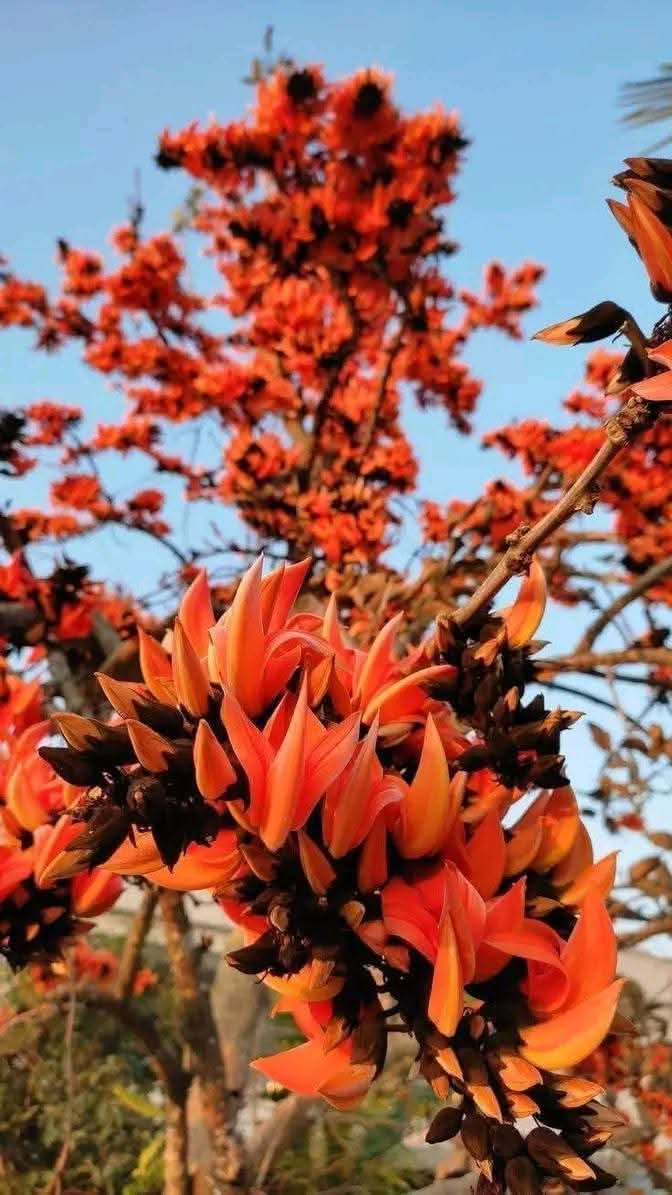
By Dr. Manisha Bhardwaj, Botanist and Educationist
The change of seasons is such a beautiful creation of nature which shows the unbreakable bond between human life and nature. In the spring season, nature leaves its winter sleep and adorns itself with new energy and new life. The auspicious beginning of this king of seasons, spring, does not begin without worshipping the Palash tree. Because the Palash tree is the herald and harbinger of the arrival of spring, which gives the message of nature’s rebirth with its fiery aura.
Palash is also called ‘Kinshuk’ in Sanskrit. Other popular names of Palash tree are Tesu, Dhak, Palas, Chhul, Parasa, Kesu, Kesudo, Palasha, Muttukkadu, Palasamara, Chalchitta, Palasi and Khakhara. Palaash, which blooms in spring and spreads its beauty even in the scorching heat of summer, adds liveliness of colors to the dry landscape of summer.
The Palash tree is given the status of a “divine tree” in the Vedas, Puranas and Smritis. Its leaves, flowers and wood are considered a symbol of purity, power and salvation in religious rituals, yajnas and deva puja. From Shivratri to Holika Dahan, its use is deeply ingrained in Indian culture.
Famous poet and lyricist of Hindi literature Shri Narendra Sharma has beautifully described the Basant Ki Aag i.e. the blooming of Palaash flowers and the arrival of spring season in his creations. Great poets like Kalidas have compared Palaash flowers to the flame of fire in their creations. In the creations of Mahakavi Kalidas, Palaash flowers are a symbol of human emotions, culture and traditions.
Wonderful relationship between Rabindranath Tagore and Palash
There is also a wonderful relationship between Guru Rabindranath Tagore and Palash tree which is associated with the arrival of spring season, beauty of life and growth. Tagore saw Palash not only as a tree but also as a symbol of beauty of nature, enthusiasm and celebration of life and brought alive the Vasantotsav of Shantiniketan with Palash flowers.
When the bright orange red flowers of Palash tree bloom, it seems as if the whole forest is covered with these flowers. This scene is grand and lively and creates the illusion of fire. This is the reason why this tree was adorned with the poetic name “Jungle Ki Aag” or “Jungle Ki Jwala”.
A silent witness to the historic battle of Plassey
This same Palash tree is also a silent witness to the historic battle of Plassey which changed the history of India. In this war, the East India Company defeated Siraj-ud-Daulah, the Nawab of Bengal. Palash trees were found in abundance in this region, due to which it was named Plassey and its red flowers remind us of the bloodshed and sacrifice of the war.
Palash is also mentioned in many folk-tales, songs and regional traditions, such as in the Holi songs in regions like Bihar, Jharkhand, and Madhya Pradesh, Palash flowers are considered a symbol of “love and celebration”.
“Palash tree is very dear to Lord Vishnu. Brahma resides in its roots, Vishnu in its branches and Shiva in its leaves.” It is also known as ‘Brahmavriksha’ and its leaves are considered to be ‘tridal’ (three-leaved) and a symbol of Tridevas (Brahma, Vishnu, Mahesh) is written in Padmapuran
Wood used in yagya and havan
By performing havan with samidha (wood) of palash, one gets freedom from all sins and attains Vaishnav pad (blessing of Lord Vishnu). Palash wood is used in yagya and havan, because it is considered pure and holy.
The phytochemicals (chemical compounds) present in Palash have served as an important bridge between modern science and traditional medicine.
Its various parts such as flowers, leaves, seeds, bark and gum are rich in medicinal properties which are used in Indian systems of medicine such as Ayurveda, Unani, Siddha, and traditional medicine. In Charaka Samhita, Palaash is described as Katu (pungent), Kashaya (astringent) in digestion, and Madhura (sweet).
It pacifies Raktapitta (blood disorder), kills worms, and is helpful in wound healing. Its bark, leaves, and flowers are used in the treatment of various diseases.In Sushruta Samhita, Palaash is described as “Vata-Kapha Nashak”.
Maintains ecological balance
This tree also contributes significantly in maintaining ecological balance like green cover. Its deep roots prevent soil erosion, store groundwater and increase soil fertility by nitrogen fixation. The flowers attract pollinators, while the seeds and pods provide food to birds and animals.
The Palash tree acts as a carbon absorber by absorbing carbon dioxide from the atmosphere, improves microclimate by increasing greenery on barren land and controls temperature. Farmers plant it on the boundaries of the fields, which improves the quality of the soil and increases crop production.
Although the Palash is invaluable for the environment, its population is declining due to excessive felling, land use change, and destruction of natural habitats. Its conservation is necessary for its sustainable use. The Palash tree is the cultural pillar of the earth, which has flowers like the peak of fire, leaves symbolizing the trinity, and roots that write the tale of struggle. Its redness is spread as color in the joy of Holi, while its bark becomes the manuscript of Ayurveda and gives the mantra of health to man.
When the leaves of the Palash fall, they merge with the soil and pledge to start a new life. When its pods break, the seeds scatter to every corner of the earth, sharing stories with the wind. This tree reminds man that the cradle of civilization shakes in the lap of nature.
Just as its roots hold the soil, similarly man should also remain connected to the roots of his culture and nature. This image of the Palash will always remind us that “beauty is meaningful only when it nourishes society and the environment.”







